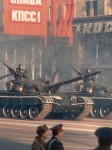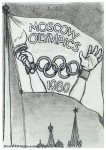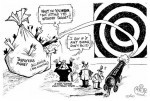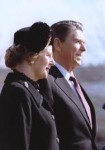
By the mid-1970s, both Cold War superpowers were preoccupied with domestic issues. The United States was grappling with the aftermath of the Vietnam War and the Watergate scandal, while the Soviet Union was struggling to revive its stagnating economy. Relations between Washington and Moscow had improved, leading many to believe that Détente would continue into the next decade. In 1975, representatives of 35 countries met in Finland and signed the Helsinki Accords, a commitment to respect the borders, sovereignty and rights of other countries. The 1970s also produced two successful Soviet-American summits: the Strategic Arms Limitation Talks, or SALT I and SALT II. SALT I, signed in 1972, produced an agreement to freeze the numbers of ballistic missile launchers at current levels. SALT II, concluded in 1979, codified an agreement to limit the manufacture of nuclear weapons and new missile systems. There was some criticism that SALT II had not gone far enough to reduce nuclear weapons stockpiles – but it marked progress nevertheless. Whatever the outcomes, the two superpowers now seemed more willing to negotiate on critical issues.
Beneath the surface, however, Cold War mistrust continued to fester. The US and USSR maintained their active and secret support for political leaders, revolutionaries and paramilitary groups around the world, mainly in Africa and South America. Both superpowers continued to initiate and support covert operations, espionage and assassinations. In America, the arms race was reinvigorated by startling new revelations. In 1976 the White House convened an investigative committee to review intelligence assessments of the Soviet military threat. Dubbed ‘Team B’, the committee was headed by anti-communist historian Richard Pipes and filled with other hardliners. Team B spent months examining intelligence reports on Soviet military strength and strategy. Their report, made public in 1976, claimed American intelligence agencies had grossly underestimated the USSR’s nuclear arsenal, weapons systems and battle plans. According to Team B, the Soviets not only had the tools to win a nuclear war but many in the Soviet military hierarchy believed they could. Though many of Team B’s assessments were later discredited, they helped bring about the end of Détente and prompted the Carter administration to increase military spending.

The final nail in the coffin of Détente was Moscow’s invasion of Afghanistan in December 1979, in order to prop up the left-wing regime there. This prompted some extraordinary rhetoric from the normally placid Jimmy Carter. The president called the Soviet invasion “the most serious threat to peace since the Second World War”, ordered that grain and goods shipments to Russia be halted, and supported a US boycott of the 1980 Olympic Games in Moscow. In November 1980, Carter was replaced as president by Ronald Reagan, an actor turned politician known for his bellicose anti-communism. Reagan declared his determination to ‘rollback’ communism, rather than to coexist with and tolerate it. He found a strong-minded ally in newly-elected British prime minister Margaret Thatcher. Both resolved to confront Soviet communism directly and bring the Cold War to a conclusion. The USSR during this period was still led by Leonid Brezhnev, Nikita Khrushchev‘s successor and one of the architects of Détente. Brezhnev was in very poor health by the late 1970s, however, and played a much smaller role in policy and decision-making.
The first years of Reagan’s presidency were marked by increases in military spending and hostile rhetoric. This was met with angry retorts from his Soviet counterparts, Yuri Andropov and Konstantin Chernenko. For this reason, the first half of the 1980s is sometimes known as the Second Cold War. Reagan was especially prolific with his criticisms of Soviet communism and imperialism. In 1982, the president delivered a speech to the British parliament where he predicted that human progress would leave Marxism-Leninism “on the ash-heap of history, as it has left other tyrannies which stifle the freedom and muzzle the self-expression of the people.” The following year, while addressing Christian leaders in Florida, Reagan pledged to retain America’s nuclear arsenal because the Soviet Union was an “evil empire” that deserved “total elimination”. Soviet leaders responded in kind, claiming that Reagan was only capable of thinking “in terms of confrontation and bellicose, lunatic anti-Communism”.

The early 1980s saw the revival of the Cold War arms race. Though Reagan had campaigned on promises to slash government expenditure, Reagan dramatically increased defence spending. In 1985, US military spending peaked at $US456 billion or almost a half-trillion dollars, a $US130 billion increase from 1980. Fuelled by the now-discredited warnings of Team B, Washington sought to bridge a perceived ‘missile gap’ with the Soviets. When the Russians deployed medium-range SS-20 nuclear-capable missiles in East Germany and Czechoslovakia in 1984, the US responded by installing Pershing II missiles in West Germany. Reagan also spent vast amounts on research, believing the arms race would be won by technological superiority as much as by firepower or nuclear yield. In 1983, he initiated a program called the Strategic Defense Initiative (SDI) to defend the US from a ballistic missile attack. This would be accomplished by ground-based defences and, eventually, through the use of space technology. Missiles would be destroyed in sub-orbital flight by smaller missiles or laser beams mounted in artificial satellites. SDI was incredibly ambitious for the time and many critics queried whether it was even possible. The sceptical American press dubbed the SDI program ‘Star Wars’. Despite its implausibility, more than $US100 billion was invested in SDI’s space research alone.
“In [Reagan’s] view, the only possibility worth entertaining was that of converting the Soviet Union into a Western democracy, and thereby realising the Wilsonian dream of eternal peace among free, civilised and God-fearing nations. Anything short of a complete ideological conversion would produce only disappointment and deepening disillusionment in the West, further undermining prospects for peaceful coexistence with an ‘evil empire’. The terms of Reagan’s bargain were the legacy of Cold War rhetoric in America.”
Robert L. Ivie
Why did Ronald Reagan reignite the Cold War by increasing defence spending and provoking the Soviet Union? Some of Reagan’s critics on the left attributed these actions to his thoughtless antipathy to communism. Others saw Reagan as a Christian evangelical warmonger who sought confrontation with the USSR. In reality, there was more purpose and planning behind Reagan’s belligerence. Perhaps the best evidence of this can be found in National Security Decision Directive 75, a policy directive issued by Reagan in January 1983. More than any other single document, NSDD-75 outlines how the Reagan administration planned to win the Cold War. The United States, it said, would compete with the Soviet Union militarily, “to contain and over time reverse Soviet expansionism”. Reagan and his advisors understood that the Soviet economy was stagnant, in dire need of reform and on the verge of significant change if not collapse. Reagan aimed to pressure the USSR to speed up “the process of change toward a more pluralistic political and economic system”. Reviving the arms race, for example, would place additional economic strain on Moscow.

Whatever Reagan’s political agenda, the dangers of nuclear confrontation remained real. In September 1983 a Korean passenger jet flying from New York to Seoul accidentally strayed into Russian airspace. It was attacked and destroyed by Soviet jets, and all 269 people on board were killed. Among them was Larry McDonald, a sitting member of the US Congress. This incident caused outrage in the West. Reagan described it as a “massacre”, “a crime against humanity” and “an act of barbarism”. The Soviets claimed the jet was hundreds of miles off course, deep in Soviet territory and failing to answer numerous radio challenges. Three weeks later, the Soviet Union’s nuclear warning computers detected an incoming ballistic missile, apparently launched from the US. Only some diligent checking by a Soviet officer, Stanislav Petrov, prevented a reciprocal attack. A similar situation occurred in November when NATO forces commenced Able Archer, a simulated launch of strategic nuclear weapons. Unaware that Able Archer was an exercise, some in Moscow interpreted it as a first strike against the USSR. Soviet missiles, bombers and nuclear submarines were placed on high alert.

1. The Second Cold War began to unfold in the late 1970s and continued into the 1980s. It marked the end of Détente, which had produced arms reduction treaties and better relations.
2. Two contributing factors were the Soviet invasion of Afghanistan and the election of Ronald Reagan in 1980. Reagan resolved to rollback Soviet communism rather than contain it.
3. Reagan applied pressure to the Soviet leadership with belligerent anti-communist rhetoric, increased military spending and the authorisation of new defence programs like SDI.
4. Changes of leadership elsewhere – such as Margaret Thatcher’s election in Britain and Brezhnev’s decline in the USSR – also contributed to this revival of Cold War tensions.
5. This revival of the Cold War arms race caused consternation around the world. There were incidents and potential flashpoints, such as the 1983 Korean air disaster and several false alarms, that could have led to confrontation and possible war.

Jimmy Carter protests the Soviet invasion of Afghanistan (December 1979)
Brezhnev responds to Carter’s protests about Afghanistan (December 1979)
President Jimmy Carter on the Soviet invasion of Afghanistan (January 1980)
Ronald Reagan explains his foreign policy if elected (October 1980)
Ronald Reagan addresses the British parliament (June 1982)
National Security Decision Directive 75 (January 1983)
President Ronald Reagan’s ‘Evil Empire’ speech (March 1983)
Transcripts from Soviet personnel during the attack on Korean Air Flight 007 (September 1983)
Ronald Reagan’s address to the nation on the Korean air disaster (September 1983)
Ronald Reagan on the international response to Flight 007 (September 1983)
Content on this page is © Alpha History 2018. This content may not be republished or distributed without permission. For more information please refer to our Terms of Use.
This page was written by Jennifer Llewellyn, Jim Southey and Steve Thompson. To reference this page, use the following citation:
J. Llewellyn et al, “The Second Cold War”, Alpha History, accessed [today’s date], https://alphahistory.com/coldwar/second-cold-war/.
